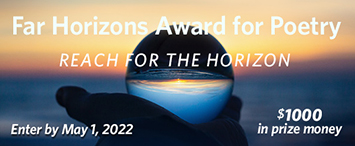|
|
Only 3 weeks left to submit!

Calling all emerging writers—this contest is specifically for those who have yet to publish a book of poetry. Submit your poem(s) by May 1 at 11:59pm PDT. One winner will take home the CAD $1,000 prize!
This year's judge:
Laura Ritland
Entry fee (includes a one-year print subscription):
$25 CAD for each entry from Canada
$35 CAD for each entry from elsewhere
$15 CAD for each
additional entry, no limit!
Full contest guidelines on our website.
interview with 2022's Open Season Poetry Award winner, Kaitlin Debicki
 Open Season Awards poetry judge Conor Kerr talks with the Open Season Poetry Award winner about belonging in two worlds, eco-eroticism, and how the Kanien’kéha words in her poem, "Kahkhwí:yo" are ones that contain multitudes. Open Season Awards poetry judge Conor Kerr talks with the Open Season Poetry Award winner about belonging in two worlds, eco-eroticism, and how the Kanien’kéha words in her poem, "Kahkhwí:yo" are ones that contain multitudes.
CK: One of the things that really stuck out for me was the nuance of language you used and how you used Kanien’kéha words in a way that allowed for readers who don’t know the language to still have an understanding of the context. Can you tell me a bit more about your process in doing this?
KD: Thanks so much for your kind words about “Kahkhwí:yo.” I’ve been an ad-hoc language learner since my undergraduate days, back in the early 2000s. Whenever I have the funds and the time to take a class in Kanien’kéha, I do. Luckily, my reserve—Six Nations of the Grand River—has done a tremendous amount for language revitalization. Six Nations Polytechnic offers language classes in Kanien’kéha (Mohawk) and Gayogo̱hó꞉nǫʼ (Cayuga) and we have an immersion school—Onkwawenna Kentyohkwa—which I would love to attend one day. As someone who was adopted out of her community at birth and raised by white folks, I am always looking for ways to reconnect to myself, my community, and my culture. This belonging in two worlds thing isn’t unusual, of course, and is often talked about through the metaphor of having one foot in two canoes, which is a reference to the Two Row Wampum—one foot in the European sailing ship and one foot in the onkwehonwe canoe. When I write, I think that in-betweenness comes through in all sorts of ways, including my use of the language. Often the Kanien’kéha words that I use are ones that contain multitudes. In other words, I can express more through the use of the word wahta than I can through the word maple. And maple has so many colonial connotations with the Canadian flag. Wahta, on the other hand, connects us to the Wahta reserve and is not loaded with the same assumptions of inanimate being. Kanien’kéha is a language of actions and images; first-language speakers and long-time speakers describe seeing images in their mind when they speak. I am still a beginner, but even I have had moments like this, where language appears in my brain differently than it does with English. Often, then, my language choices have to do with what I am seeing and feeling, internally. Kahkhwí:yo is my way of saying beautiful food—kahkwa means sustenance and the suffix, i:yo, means good or beautiful. It isn’t a perfect translation, but I was interested in representing food, beauty, bodies, desire, and trees together as one. I felt that kahkwí:yo let me do that.
Read the rest of Kaitlin Debicki's interview.
interview with Open Season Fiction Award winner, Sara Mang
 Open Season Awards fiction judge Zilla Jones talks with the Open Season Fiction Award winner about mime as a tragicomic mastery of silence, fully immersing herself in a project, and her choice of a military college as the setting for her story, "The Circular Motion of a Professional Spit-Shiner." Open Season Awards fiction judge Zilla Jones talks with the Open Season Fiction Award winner about mime as a tragicomic mastery of silence, fully immersing herself in a project, and her choice of a military college as the setting for her story, "The Circular Motion of a Professional Spit-Shiner."
ZJ: Joyce has a personal history of trauma in her body. I was struck by the line, “It is not that she has to make herself believe that she is on a tightrope; she has to forget the tightrope isn’t there.” What is the significance of mime in the story, and why did you choose to have Joyce participate in mime specifically?
SM: This question touches upon the very origins of this story. I participated in a writing challenge hosted by NYC Midnight and received three prompts: mime, obsolete and ghost story. As I researched mime, I fell deeply in love with the physical and physiological expansiveness that accompanied the tragicomic mastery of silence. I watched many videos of Marcel Marceau, the great French mime and war hero who saved at least 70 Jewish children through undercover border crossings during World War II. There was an exciting connection between Marceau’s life and work, and the story that was evolving in my mind.
Joyce appeared in the earliest stages of the story as a feminine being within the masculine environment of a military college. It was impossible for her to express herself authentically in this environment because the very framework of the military college system encouraged a particular style of leadership that was incongruent with her nature. I wanted to explore the bewildering experience of a female protagonist who is ambitious and intelligent, but also young and uncertain. The story evolved and gradually lost the magical element of ghost Fairbanks, but mime served as the medium through which I could explore Joyce’s personhood, her body and its non-verbal ways of communicating emotion, of coping. Mime satisfied the main narrative tension which involved Joyce’s ability and inability to ignore elements of her surroundings. She had to imagine a world in which she might survive and even thrive, because her reality was a place that lacked the support and nourishment she needed. Read the rest of Sara Mang's interview.
|
|
|
|
|
|
|
|
|
|
|
|